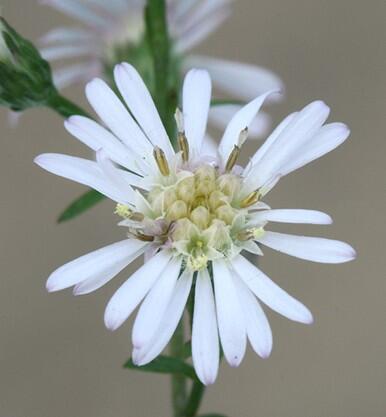- Scientific name: Symphyotrichum tradescantii
- Species of Greatest Conservation Need (MA State Wildlife Action Plan)
- Threatened (MA Endangered Species Act)
Description

Tradescant’s aster is a graceful, branched, white-rayed aster (family Asteraceae) that seldom grows to more than 45 cm (1.5 ft) in Massachusetts. It is often found with a rosette of basal leaves and a cluster of slender, erect stems.
Heads typically have 14 to 25 (but sometimes >25) white rays, and a complement of 20 to 30 pale yellow to cream colored disc florets, which turn magenta after pollination. Lobes of the disc florets are recurved when fully open. Flowering branches are arranged in panicles, with flower heads located mainly at the ends of short, straight, upward-pointing branches. Stems are smooth but may become finely hairy in lines higher on the plant where flowers are found. The upward-pointing leaves are lance-shaped and sharp-pointed, and gradually become smaller higher on the stem and on branches. Phyllaries (involucral bracts) are not spreading or recurved; they have tips with a distinct darker green patch that may sometimes be tinged with purple.
Tradescant’s aster is most likely to be confused with two of the white-rayed aster species with small heads (1.0-1.5 cm width; 0.4-0.6 in), especially calico aster (S. lateriflorum) and smooth white oldfield aster (S. racemosum). Normal to very robust specimens of calico aster and white oldfield aster have branches that are less steeply ascending and more recurved than those of Tradescant’s aster. Flower heads for calico aster and smooth white oldfield aster are more numerous and crowded on the branches and are more distinctly arranged on one side of the branch than are those of Tradescant’s aster. Stem and branch leaves of Tradescant’s aster may be spreading or ascending but are never reflexed. Disc corolla lobes of all three species may flare outwards and recurve to some extent, but those of calico aster do so to a greater extent; however, this difference may be difficult to perceive or measure. Specimens of calico aster that are found in the same habitat types as Tradescant’s aster (i.e., seasonally inundated river bottoms, banks, and ledges) may be stunted and thus mimic Tradescant’s aster. In those situations, the best way to tell the two species apart is to count disc and ray florets. Calico aster has fewer disc florets (8 to 16) and generally fewer ray florets (8 to 15).
Life cycle and behavior
This species blooms from mid-July into September during periods when water levels are low.

Population status
Tradescant’s aster is listed under the Massachusetts Endangered Species Act as Threatened. All listed species are protected from killing, collecting, possessing, or sale and from activities that would destroy habitat and thus directly or indirectly cause mortality or disrupt critical behaviors. This species is currently known from Franklin and Hampden Counties and is historically known from Norfolk County.
Distribution and abundance
This species ranges from Quebec, south to New York and New Jersey, and east to the Canadian Maritime Provinces. Within New England, it is more common in more northerly states and reaches its southern limit in Massachusetts.

Habitat

Tradescant’s aster is typically found tenaciously rooted in fissures and cracks of rocky stream or riverbanks and adjacent exposed ledges that are at or below the high-water mark. The habitat is subject to flooding during much of the year, and this species flowers during periods in summer when waters have receded. Associate species vary among sites, but some include running serviceberry (Amelanchier stolonifera), Indian hemp (Apocynum cannabinum), upland white aster (Oligoneuron album, Endangered), big bluestem (Andropogon gerardii), and various asters including New York aster (Symphyotrichum novae-belgii).
Healthy habitats are vital for supporting native wildlife and plants. Explore habitats and learn about conservation and restoration in Massachusetts.
Threats
The disturbance regime of Tradescant’s aster habitat, which includes flooding and ice scour, makes it relatively inhospitable to many exotic invaders and aggressive woody plants; therefore, maintenance or emulation of the natural hydrologic regime is likely important for the maintenance of habitat quality. Despite the harsh conditions, some invasive plants, including spotted knapweed (Centaurea maculata) and purple loosestrife (Lythrum salicaria) have been documented within or near some habitat locations; therefore, Tradescant’s aster populations should be monitored for encroaching invasive species. Shoreline development and recreational use are also potential threats.
Conservation
If competition from invasive plants or aggressive native plants is deemed a threat, pruning or other means of vegetation control may be warranted. Development and recreation (e.g., trails, boat launch areas) should be directed away from Tradescant’s aster habitat. All active management of rare plant populations (including invasive species removal) is subject to review under the Massachusetts Endangered Species Act and should be planned in close consultation with MassWildlife’s Natural Heritage & Endangered Species Program.
References
NatureServe. 2010. NatureServe Explorer: An online encyclopedia of life [web application]. Version 7.1. NatureServe, Arlington, Virginia. Available http://www.natureserve.org/explorer. (Accessed: January 28, 2011).
Contact
| Date published: | May 7, 2025 |
|---|